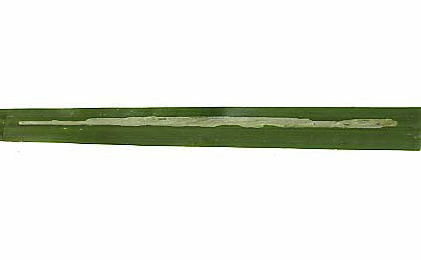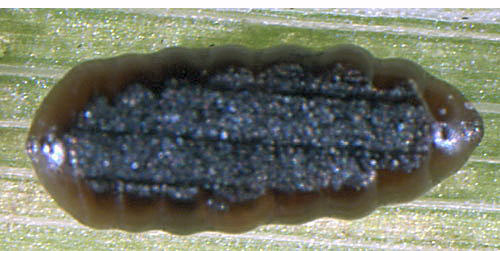|
||||||
| Cerodontha angulata (Loew, 1869) [Diptera: Agromyzidae] |
||||||||||||||||||||||||||||||||||||||||||||||||||||||||||||||||||||
|
Agromyza
angulata Loew, 1869a. Berl. ent. Z. 13(1-2):
47 |
||||||||||||||||||||||||||||||||||||||||||||||||||||||||||||||||||||
Leaf-miner: A long yellowish green leaf-mine. Pupation external, puparium frequently adhering to leaf (Spencer, 1972b: 100; Spencer, 1976: 205). Long, rather broad corridor, about halfway along the leaf blade. Frass in a few large, black lumps. Puparium formed now in, then outside the mine (Bladmineerders van Europa). Larva: The larvae of flies are leg-less maggots without a head capsule (see examples). They never have thoracic or abdominal legs. They do not have chewing mouthparts, although they do have a characteristic cephalo-pharyngeal skeleton (see examples), usually visible internally through the body wall. The larva is described by de Meijere (1926, as semiposticata), Nowakowski (1973) and Dempewolf (2001: 113). The larva is illustrated in Bladmineerders van Europa. Puparium: The puparia of flies are formed within the hardened last larval skin or puparium and as a result sheaths enclosing head appendages, wings and legs are not visible externally (see examples). Oval, dark brown, without conspicuous segmentation, frequently adhering to leaf (Spencer, 1972b: 96 (fig. 331), 100; Spencer, 1976: 205, figs 355-6). Yellow to black-brown (Bladmineerders van Europa).
Comments: Carex ovalis is treated as Carex leporina (Oval Sedge) by Stace (2010). Hosts in Great Britain and Ireland:
Hosts elsewhere: Time of year - mines: September, November. Time of year - adults: Currently unknown. Distribution in Great Britain and Ireland: Widespread in the southern Britain including London (Hampstead), Middlesex (Scratch Wood), Dorset (Lyme Regis), Glam. (Spencer, 1972b: 100), Warwickshire (Coventry) (Robbins, 1991: 133) and Cardiganshire, East Sutherland, Leicestershire and Surrey (NBN Atlas). Also recorded in the Republic of Ireland (Fauna Europaea). Distribution elsewhere: Widespread in continental Europe including Denmark, Sweden, Norway (Spencer, 1976: 205), The Netherlands, Luxembourg (Bladmineerders van Europa), Belgium (Scheirs, de Bruyn and von Tschirnhaus, 1995), Germany (Spencer, 1976: 554; Dempewolf, 2001: 113), Austria, Czech Republic, Estonia, European Turkey, French mainland, Hungary, Italian mainland, Lithuania, Poland, Romania and Slovakia (Fauna Europaea). Also recorded in Canada and the U.S.A. (Spencer, 1976: 205). NBN Atlas links to known host species: British and Irish Parasitoids in Britain and elsewhere:
|
|
|
|
| External links: | Search the internet: |
| Biodiversity Heritage Library Bladmineerders van Europa British leafminers Encyclopedia of Life Fauna Europaea NBN Atlas NHM UK Checklist |
Find
using Google Find using Google Scholar Find images using Google |
| Last updated 09-Jul-2019 Brian Pitkin | ||


